story by Kayte Deioma
Whether you’re interested in science, a fan of all things extraterrestrial, or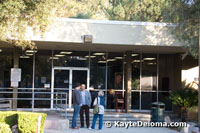 just occasionally look up at the moon and the stars, a tour of the Jet Propulsion Laboratory (JPL) in Pasadena will give you a new perspective on the night sky. It’s not something you can decide to do at the last minute on a rainy day because you have to make reservations in advance, so don’t wait for the rain to make your plans. If it does rain, you’ll need your umbrella for walking between the buildings.
just occasionally look up at the moon and the stars, a tour of the Jet Propulsion Laboratory (JPL) in Pasadena will give you a new perspective on the night sky. It’s not something you can decide to do at the last minute on a rainy day because you have to make reservations in advance, so don’t wait for the rain to make your plans. If it does rain, you’ll need your umbrella for walking between the buildings.
History of JPL
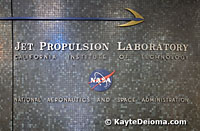 In the 1930s, a group of students at the California Institute of Technology (Caltech) were experimenting with rocket propulsion. After the explosions and the smell got them banned from campus, they found a spot a few miles away in a dry river bed at the foot of the San Gabriel Mountains to set off their rockets, and the Jet Propulsion Laboratory was born. The growing success of their rocket experiments brought in government funding and contracts with the U.S. Army.
In the 1930s, a group of students at the California Institute of Technology (Caltech) were experimenting with rocket propulsion. After the explosions and the smell got them banned from campus, they found a spot a few miles away in a dry river bed at the foot of the San Gabriel Mountains to set off their rockets, and the Jet Propulsion Laboratory was born. The growing success of their rocket experiments brought in government funding and contracts with the U.S. Army.
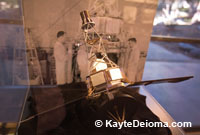 In January 1958, following on the heels of Russia’s Sputnik satellite launch, JPL created the first U.S. satellite to be sent into space, the Explorer I. When the National Aeronautics and Space Administration (NASA) was formed later that year, JPL was invited to be the lead research and development arm for NASA robotics. Since then, JPL has sent over 50 space exploration robots out into our solar system and currently has 17 research modules from satellites to the Mars Exploration Rovers, sending back signals to scientists on the ground. The oldest of these, the Voyager 1 and 2 have been in space since their 1977 launch and continue to send back signals from the far reaches of the universe.
In January 1958, following on the heels of Russia’s Sputnik satellite launch, JPL created the first U.S. satellite to be sent into space, the Explorer I. When the National Aeronautics and Space Administration (NASA) was formed later that year, JPL was invited to be the lead research and development arm for NASA robotics. Since then, JPL has sent over 50 space exploration robots out into our solar system and currently has 17 research modules from satellites to the Mars Exploration Rovers, sending back signals to scientists on the ground. The oldest of these, the Voyager 1 and 2 have been in space since their 1977 launch and continue to send back signals from the far reaches of the universe.
JPL operates NASA’s Deep Space Communication Network of three massive antennas placed strategically around the world to pick up signals from satellites and deep space research robots. Since this is the only network of its kind, they are also responsible for communications with research satellites sent into space by other countries.
The JPL Tour
Once a week, on Wednesday afternoons, the general public has an opportunity to visit the Jet Propulsion Laboratory to get a glimpse of what they do. Tours meet in the Visitor Reception building and proceed into a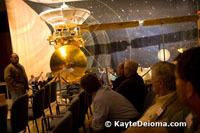 small theater with large scale models of some of the more famous space exploration robots on display. The guide gives a brief history of JPL before showing a short film that gives a refresher course on the solar system and some of the highlights of what the research vessels have found. Exciting footage puts you in the control room with JPL scientists and engineers as the Mars Rover lands successfully on the red planet.
small theater with large scale models of some of the more famous space exploration robots on display. The guide gives a brief history of JPL before showing a short film that gives a refresher course on the solar system and some of the highlights of what the research vessels have found. Exciting footage puts you in the control room with JPL scientists and engineers as the Mars Rover lands successfully on the red planet.
After the film, you have an opportunity to get a better look at the model of the 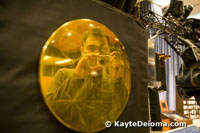 Voyager, with its golden record on the front, conceived by Carl Sagan. You can also hear a piece of the recording which contains greetings in 60 languages, bits of music and other cultural sounds of the 70s, and see the 117 pictures that were chosen to represent humanity on earth. In case there is intelligent life out there somewhere, pictographic instructions are etched on the record cover describing how to play it. Other models on display include the Mars Global Surveyor, the Mars Odyssey Orbiter, and the Cassini Spacecraft andHuygens Probe, currently circling Saturn and its moon, Titan.
Voyager, with its golden record on the front, conceived by Carl Sagan. You can also hear a piece of the recording which contains greetings in 60 languages, bits of music and other cultural sounds of the 70s, and see the 117 pictures that were chosen to represent humanity on earth. In case there is intelligent life out there somewhere, pictographic instructions are etched on the record cover describing how to play it. Other models on display include the Mars Global Surveyor, the Mars Odyssey Orbiter, and the Cassini Spacecraft andHuygens Probe, currently circling Saturn and its moon, Titan.
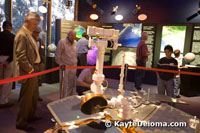 Next to the theater is the JPL Museum. A full scale Mars Exploration Rover and many smaller scale models of spacecraft are on display. Globes of planets and moons indicate named features that have been documented by the space explorers. While older members of our group honed in on trying to find their houses on a large satellite map of Southern California, James, who looked to be about 5, raced from model to globe to model calling to his friend, “Thunder, you gotta see this!”
Next to the theater is the JPL Museum. A full scale Mars Exploration Rover and many smaller scale models of spacecraft are on display. Globes of planets and moons indicate named features that have been documented by the space explorers. While older members of our group honed in on trying to find their houses on a large satellite map of Southern California, James, who looked to be about 5, raced from model to globe to model calling to his friend, “Thunder, you gotta see this!”
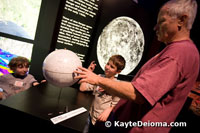 Large scale photos of the birth and death of stars, taken from the Hubble Space Telescope, adorn one wall. A sample of Silica Aerogel, also known as “solid blue smoke” has a certificate from the Guinness Book of World Records for being the lightest solid substance in the world. In the next museum display, they project a neat little light show on blocks of the smoky substance. In space, among other things, they use it to capture particle samples.
Large scale photos of the birth and death of stars, taken from the Hubble Space Telescope, adorn one wall. A sample of Silica Aerogel, also known as “solid blue smoke” has a certificate from the Guinness Book of World Records for being the lightest solid substance in the world. In the next museum display, they project a neat little light show on blocks of the smoky substance. In space, among other things, they use it to capture particle samples.
After the museum, the tour passes through an administration building to the Space Flight Operations Facilityand upstairs to a viewing theater overlooking the Deep Space Operations Center. No photos are allowed here.
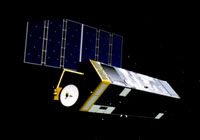 From the video, you know that this nerve center of operations is filled with wall to wall scientists and engineers when it’s time for a launch or landing. It looks a lot like other NASA control rooms you see in the news and the movies for the launch of manned space missions. On an ordinary day, most of the three rows of consoles in the main room and more work stations in a windowed area off to the side are unoccupied. On our visit, five people are at their monitors, keeping track of all the unmanned spacecraft in the universe.
From the video, you know that this nerve center of operations is filled with wall to wall scientists and engineers when it’s time for a launch or landing. It looks a lot like other NASA control rooms you see in the news and the movies for the launch of manned space missions. On an ordinary day, most of the three rows of consoles in the main room and more work stations in a windowed area off to the side are unoccupied. On our visit, five people are at their monitors, keeping track of all the unmanned spacecraft in the universe.
Our guide explains the Universal Time Clock that keeps all the Deep Space operations around the world on the same time. In addition to the UTC clock, there are clocks for each of the Mars Exploration Rovers, Spiritand Opportunity that have rolled over to zero and had to have the years added, because they have continued to function so long after their projected lifespan.
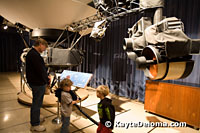 Using flat planets stuck on a carpet wall, we get a lesson in space distances. The comparison that most resonates with me is the time it takes to send and receive messages. It takes 1.5 seconds for a message to reach the moon, which is a mere 384,000 miles from Earth. It takes over 14 hours for a message to travel to the Voyager 1 spacecraft. At 10 billion miles from Earth and counting, it is the most distant human creation in the universe. Traveling at about 39,000 miles per hour, Voyager 1 should reach the outer boundary of our solar system within the next 10 years. Hopefully its 1977 nuclear batteries will still be running to tell us what’s out there.
Using flat planets stuck on a carpet wall, we get a lesson in space distances. The comparison that most resonates with me is the time it takes to send and receive messages. It takes 1.5 seconds for a message to reach the moon, which is a mere 384,000 miles from Earth. It takes over 14 hours for a message to travel to the Voyager 1 spacecraft. At 10 billion miles from Earth and counting, it is the most distant human creation in the universe. Traveling at about 39,000 miles per hour, Voyager 1 should reach the outer boundary of our solar system within the next 10 years. Hopefully its 1977 nuclear batteries will still be running to tell us what’s out there.
The final stop on the tour is the In Situ Instrument Laboratory. From a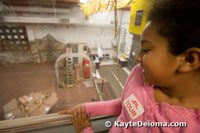 glassed-in walkway you can look down on a Mars simulation room where a replica of the Mars Rover is used to test out program directions before they are sent to the Rovers on Mars. If there is a problem with the Spirit or Opportunity Rovers, the problem is recreated and solved with the replica Rover and then the solution is uploaded to the research vehicles on Mars. It takes about 15 minutes to send a signal to Mars – a lot closer than the Voyager 1.
glassed-in walkway you can look down on a Mars simulation room where a replica of the Mars Rover is used to test out program directions before they are sent to the Rovers on Mars. If there is a problem with the Spirit or Opportunity Rovers, the problem is recreated and solved with the replica Rover and then the solution is uploaded to the research vehicles on Mars. It takes about 15 minutes to send a signal to Mars – a lot closer than the Voyager 1.
I<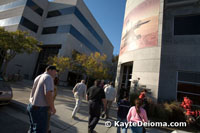 f you’re traveling with a group of 10 or more, special tours can be arranged outside of the Wednesday public tours. JPL also holds an annual two-dayOpen House in May where the scientists come out of their labs and bring their projects to demonstrate, from Mars Exploration Rovers and other robots to thermal imaging equipment, solar telescopes and space suits. There are also monthly lectures on space and technology-related topics that are open to the public.
f you’re traveling with a group of 10 or more, special tours can be arranged outside of the Wednesday public tours. JPL also holds an annual two-dayOpen House in May where the scientists come out of their labs and bring their projects to demonstrate, from Mars Exploration Rovers and other robots to thermal imaging equipment, solar telescopes and space suits. There are also monthly lectures on space and technology-related topics that are open to the public.
Jet Propulsion Laboratory
Public Services Office
4800 Oak Grove Drive
Pasadena, CA 91109
Phone: (818) 354-9314
www.jpl.nasa.gov
